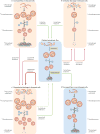Pharmacological modulation of autophagy: therapeutic potential and persisting obstacles
- PMID: 28529316
- PMCID: PMC5713640
- DOI: 10.1038/nrd.2017.22
Pharmacological modulation of autophagy: therapeutic potential and persisting obstacles
Abstract
Autophagy is central to the maintenance of organismal homeostasis in both physiological and pathological situations. Accordingly, alterations in autophagy have been linked to clinically relevant conditions as diverse as cancer, neurodegeneration and cardiac disorders. Throughout the past decade, autophagy has attracted considerable attention as a target for the development of novel therapeutics. However, such efforts have not yet generated clinically viable interventions. In this Review, we discuss the therapeutic potential of autophagy modulators, analyse the obstacles that have limited their development and propose strategies that may unlock the full therapeutic potential of autophagy modulation in the clinic.
Conflict of interest statement
The authors declare no competing interests.
Figures




References
-
- Noda NN, Inagaki F. Mechanisms of autophagy. Annu Rev Biophys. 2015;44:101–122. This comprehensive review describes the molecular mechanisms that control autophagic responses and their regulation. - PubMed
-
- Sica V, et al. Organelle-specific initiation of autophagy. Mol Cell. 2015;59:522–539. - PubMed
Publication types
MeSH terms
Grants and funding
LinkOut - more resources
Full Text Sources
Other Literature Sources
Medical
Miscellaneous

